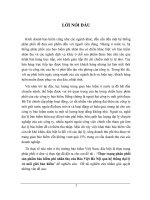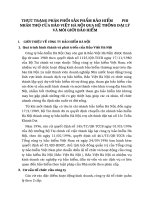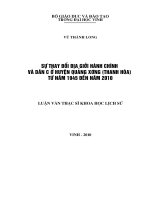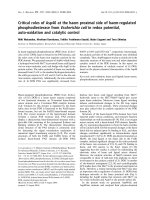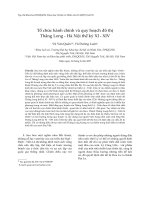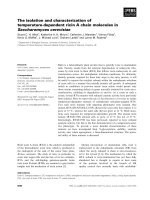The administration place names of Tho Xuong district (Thang Long – Hanoi) in 19th century Địa danh hành chính huyện Thọ Xương (Thăng Long – Hà Nội) thế kỷ 19
Bạn đang xem bản rút gọn của tài liệu. Xem và tải ngay bản đầy đủ của tài liệu tại đây (3.06 MB, 167 trang )
VIETNAM NATIONAL UNIVERSITY, HANOI
INSTITUTE OF VIETNAMESE STUDIES AND DEVELOPMENT SCIENCES
DANG PHUONG LINH
THE ADMINISTRATION PLACE NAMES
OF THO XUONG DISTRICT
(THANG LONG – HANOI) IN 19
th
CENTURY
MASTER„S THESIS
Major: Vietnamese studies
Hanoi-2013
VIETNAM NATIONAL UNIVERSITY, HANOI
INSTITUTE OF VIETNAMESE STUDIES AND DEVELOPMENT SCIENCES
DANG PHUONG LINH
THE ADMINISTRATION PLACE NAMES
OF THO XUONG DISTRICT
(THANG LONG – HANOI) IN 19
th
CENTURY
MASTER„S THESIS
Major: Vietnamese studies
Code: 60 22 01 13
Supervisors: A. Professor – Ph.D. Nguyen Thi Viet Thanh
Hanoi-2013
The administration place names of Tho Xuong district (Thang Long-Hanoi) in 19
th
century
Dang Phuong Linh Institute of Vietnamese Studies and Development Sciences
1
CONTENTS
ACKNOWLEDGMENTS 3
COMMITMENTS 4
CONVENTION 5
BEGINNING 6
1. The reasons for Thesis‟s subject 6
2. Objects of Thesis 7
3. Scope of Thesis 7
4. Purposes of Thesis 7
5. Tasks of Thesis 8
6. Methodology of Thesis 8
7. Layout of the Thesis 9
Chapter 1 10
BASIC THEORY OF TOPONYMY AND GENERAL INFORMATION OF
THANG LONG-HANOI 10
1.1. Basic theory of Toponymy 10
1.2. General information of toponymy reasearch and Thang Long-Hanoi place
name researchs 12
1.3. Overview of Thang Long – Hanoi in 19
th
century 17
1.4. Overview of Tho Xuong district in 19
th
century 19
Chapter 2 21
ADMINISTRATION PLACE NAMES OF THO XUONG DISTRICT IN
THE PERIOD 1802-1831 21
2.1. Overview of administration system of Tho Xuong district in the period
1802 – 1831 21
2.2. Precincts of Tho Xuong district in 1802 – 1831 22
2.3. Some general characteristics of Tho Xuong district‟s place names in the
period 1802-1831 40
2.4. Conclusion of chapter 2 50
Chapter 3 53
ADMINISTRATION PLACE NAMES OF THO XUONG DISTRICT
AFTER 1831 53
3.1. Administration place names of Tho Xuong district in the period 1831-
1887 53
3.2. Administration place names of Tho Xuong district after 1887 78
3.3. Conclusion of chapter 3 81
CONCLUSION 85
APPENDIX 87
The administration place names of Tho Xuong district (Thang Long-Hanoi) in 19
th
century
Dang Phuong Linh Institute of Vietnamese Studies and Development Sciences
2
Appendix 1 88
The list shows the transformation of the Tho Xuong district„s administration
place names in 2 periods 1802-1831 & 1831-1887, along with their current
location 88
Appendix 2 110
The list of current Hanoi‟s administration place names and their
corresponding locations in 3 periods: After the Revolution, in the French
colonial period & in the Nguyen Dynasty 110
REFERENCES 163
The administration place names of Tho Xuong district (Thang Long-Hanoi) in 19
th
century
Dang Phuong Linh Institute of Vietnamese Studies and Development Sciences
3
ACKNOWLEDGMENTS
I would like to express my special thanks to Associate Professor Nguyen
Thi Viet Thanh for her kind supervision.
I am grateful to the leaders of Thang Long Hanoi heritage conservation
Centre for helps during my master course.
I also give my thankfulness to my family, my colleagues and my friends
whose support and encouragement lead me to success.
Hanoi, December 6
th
, 2013
Sincerely,
Dang Phuong Linh.
The administration place names of Tho Xuong district (Thang Long-Hanoi) in 19
th
century
Dang Phuong Linh Institute of Vietnamese Studies and Development Sciences
4
COMMITMENTS
I commit that this master thesis was my own research.
The thesis‟s results were honest and have never been published in public.
Hanoi, December 6
th
, 2013
Sincerely,
Dang Phuong Linh.
The administration place names of Tho Xuong district (Thang Long-Hanoi) in 19
th
century
Dang Phuong Linh Institute of Vietnamese Studies and Development Sciences
5
CONVENTION
1. Convention table
In the thesis, we give temporary convention of some words according to
this table:
No
ENGLISH
VIETNAMESE
1
Prefect
Phủ
2
District
Huyện
3
Prefecture
Tổng
4
Hamlet
Thôn
5
Precinct
Phường
6
Camp
Trại
7
Commune
Xã
2. Convention of spelling of some place names
The thesis‟s topic is about toponymy; therefore it contains a lot of place
names which are difficult to understand if translating into English. For this
reason, we keep the spelling of some place names in Vietnamese.
The administration place names of Tho Xuong district (Thang Long-Hanoi) in 19
th
century
Dang Phuong Linh Institute of Vietnamese Studies and Development Sciences
6
BEGINNING
1. The reasons for Thesis’s subject
Place itself is an object containing linguistic factors, historical factors,
geography factors and also ethnography factors. Place name is not only the
name of an identifiable geographical location, an administration place name or a
particular building, but also the images of the elements of history, culture,
geography, anthropology of mentioned place name. For this reason, place
name is also called “stele” which records the most important marks in terms of
history, culture, geography, population of land or location named. In the
process of formation and transformation of an area, place name usually don‟t No
change but alter under the influence of many factors. These factors make place
names become “live sediments” which record valuable information of many
sciences such as linguistics, ethnography, cultural studies, history and
archaeology. With such characteristics, in recent years, many people have
chosen place name to be research object with interdisciplinary approach and
precinct orientation.
Refer to Thang Long-Hanoi, it is known that not only the biggest center of
politics, economy, and culture of our country but also the place having historical
monument which relates to the process of national founding and defence. To
learn about Thang Long-Hanoi shows us the beauty of cultural values of our
country in general and Thang Long-Hanoi in particular. However, within limit
of a master thesis, we only select to research a small part of Thang Long-
Hanoi‟s place name system which is administration place names of Tho Xuong
district in Nguyen dynasty (in 19
th
century). We selected this topic to research
because Nguyen dynasty stored much material of place names through
The administration place names of Tho Xuong district (Thang Long-Hanoi) in 19
th
century
Dang Phuong Linh Institute of Vietnamese Studies and Development Sciences
7
monography books and land register books. Besides, this is also the period
Vietnam's history is fluctuate, especially in the organizational and
administration. We choose Tho Xuong district to be the research space because
almost the Hanoi‟s nerve-centres at that time located in this district.
Within the scope of a master's thesis, we only focus on the administration
place names which are the most typical fluctuate in the place name system of
Thang Long-Hanoi in general and Tho Xuong district in particular.
2. Objects of Thesis
The object of the thesis is the administration place names of Tho Xuong
district in the 19th century (mainly in the Nguyen Dynasty). We focus on
structure, situation and transformation of Tho Xuong district‟s place names in
each history periods in 19th century.
3. Scope of Thesis
The scope of the thesis all of administration place names of Tho Xuong
district which contains 8 prefectures. Research time mainly focuses on the 19th
century when Tho Xuong district had much fluctuation under the influence of
political and social factors. Besides, we concentrate on the transformation of the
the place names from the point of language, culture and history.
4. Purposes of Thesis
The first aim of the thesis is researching administration place names of
Tho Xuong district in 19th century in terms of: identification mode, semantics,
origins and transformation, as well as culture specific characteristics.
The second aim of thesis is to describe the structure of administration
place names of Tho Xuong district in 19th century and to clear the relationship
between place names and some elements such as history, geography, ethnicity,
archeology, culture
The administration place names of Tho Xuong district (Thang Long-Hanoi) in 19
th
century
Dang Phuong Linh Institute of Vietnamese Studies and Development Sciences
8
The third aim of thesis is to study Thang Long-Hanoi in many different
angles which can contribute to restore a comprehensive picture of traditional
Hanoi.
5. Tasks of Thesis
To achieve the above purposes, thesis has to solve the following research
tasks:
- To study theories of toponymy and culture characteristic issues of place
names to be basic for further research.
- To collect all the administration place names of Tho Xuong district in
19
th
century.
- To describe, classify and analyse the administration place name system
of Tho Xuong district in 19th century according to toponymy criteria, then draw
remarks in aspects: identification mode, semantics, origins and transformation.
- To study history and culture characteristics which are expressed by this
region‟s administration place names.
- To build a document system of administration place names of Tho
Xuong district through convention tables. We put the tables in the Appendix of
the thesis which contains:
+ Appendix 1: The list shows the transformation of the Tho Xuong
district‟s administration place names in 2 periods 1802-1831 & 1831-1887,
along with their current location (22 pages).
+ Appendix 2: The list of current Hanoi‟s administration place names and
their corresponding locations in 3 periods: After the Revolution, in the French
colonial period & in the Nguyen Dynasty (47 pages).
6. Methodology of Thesis
- Survey method: study, synthesize, and collect all administration place
names of Tho Xuong district in 19th century (mainly through sources:
monography, land-register book, place-name dictionary and maps).
The administration place names of Tho Xuong district (Thang Long-Hanoi) in 19
th
century
Dang Phuong Linh Institute of Vietnamese Studies and Development Sciences
9
- Statistics method: gathering and sorting administration place names of
Tho Xuong district in 19th century on the basis of survey method.
- Description and analysis method: show structure characteristics as well
as history and culture characteristics of administration place names of Tho
Xuong district in 19th century.
- Convention method: convent administration place name system of Tho
Xuong district in each period to see changes in terms of every aspect.
7. Layout of the Thesis
Beginning
Chapter 1: BASIC THEORY OF TOPONYMY AND GENERAL
INFORMATION OF THANG LONG-HANOI
Chapter 2: ADMINISTRATION PLACE NAMES OF THO XUONG
DISTRICT IN THE PERIOD 1802-1831
Chapter 3: ADMINISTRATION PLACE NAMES OF THO XUONG
DISTRICT AFTER 1831
3.1. Administration place names of Tho Xuong district in the period
1831-1887
3.2. Administration place names of Tho Xuong district after 1887
Conclusion
The appendix
References
The administration place names of Tho Xuong district (Thang Long-Hanoi) in 19
th
century
Dang Phuong Linh Institute of Vietnamese Studies and Development Sciences
10
Chapter 1
BASIC THEORY OF TOPONYMY AND GENERAL
INFORMATION OF THANG LONG-HANOI
1.1. Basic theory of Toponymy
1.1.1. Toponymy
Toponymy is a part of lexical system of language. As well as own name,
toponymy associates with history, culture, manners and customs of a
community. Toponymy as well as other language products, is influenced and
governed by the laws of language in terms of phonetics, vocabulary - semantics
and grammar.
The term Toponymy is derived from the Greek word Topos (means
position) and Omoma/ Onyma (means name/ ). It is the
geographical names, forming a separate system, exist in the vocabulary of
various languages in the world.
There is no united definition of place , because each definition
has own opinion and approach of author. Author A.V. Xuperanxkaja wrote in
: All the geographical names sometimes have different
names: list, derived from the Latin . On
the other hand, the author says: People in all countries, in former times,
recorded all the object by place names, marks the geographical names by
words. Thus, place name is close to the name of some other sciences:
onomatology (name of man), zoology (name of animal)Accordingly, we can
generalize the definition of place name by the author‟s opinion: Place name is
the name of other geographical objects the object on the Earth's surface. Place
The administration place names of Tho Xuong district (Thang Long-Hanoi) in 19
th
century
Dang Phuong Linh Institute of Vietnamese Studies and Development Sciences
11
names marked the geographical names with words. Place names are close to
personal names, animal names.
In Vietnam, according to - by Dao Duy Anh [20],
place names are lands. “ also had very simple
explaination: place name is land name, local name [25, p.320]. Some authors
who have given contributions in research place names such as Nguyen Van Au,
Le Trung Hoa; Nguyen Kien Truong also have different opinions of place
names. Nguyen Van Au said: Places was the name of land, including: name of
rivers, mountains, hamlets or name of local peoples [18, p.5]. Nguyen Kien
Truong determined: Place names are own names of natural geography and
humanities objects which locate on the earth's surface [25, p.16]. According to
Nguyen Van Loan: Place name is own name which is represented by fixed
word or term, refers to the various geographical objects, exist on the earth's
surface. Own name in general and place name in particular also carries society
function. [30, p.11]
From the viewpoints of the home and abroad authors, we agree with the
definition of Le Trung Hoa: Place names are fixed words or terms, which are
name of nature terrain, construction, administration unit, or the territories.
Before place name, we can put a common noun that shows kind of place name:
“ Sài Gòn, Ba tơ, Bàu Trăm, Bà Quẹo…” [2, p.17].
1.1.2. Functions and duties of toponymy
Each science has own functions and research duties. The other authors
have a relatively similar view of functions and duties of toponymy. In “What is
Toponymy?, A.V.Xuperanxkaja also identified: Place name is a speciality of
linguistics, study of geographical names, explain structure and appearance
history of them and analyze the original meaning of the words that make up the
place name.
With the above definition, it is identified that toponymy includes some
basic tasks: research the formation cause and the transformation of place names,
The administration place names of Tho Xuong district (Thang Long-Hanoi) in 19
th
century
Dang Phuong Linh Institute of Vietnamese Studies and Development Sciences
12
research structure and naming method of place names, research place name in
the relationship with cultural characteristics of each region, each nation.
1.1.3. Some basic approaches to research toponymy
The first method is to study and to analyze structrure characteristics of
place names and their synchronic meanings.
The second method is to study and to find the ogirin and identification of
place names, research the transformation of place names during the development
of a land, in the direction of diachronic study.
In the both above approaches, because of the characteristics of research
object, in addition to applying the methods of linguistic research, the methods
using interdisciplinary approach to describe results in terms of language, culture,
history and even geography, anthropology are also essential.
1.2. General information of toponymy reasearch and Thang Long-Hanoi
place name researchs
1.2.1. Hitorical research of toponymy in the world
Term first appeared in England in 1876. Since then, the term
was gradually replaced by another term which is names. Place names is
research subject of many sciences as linguists, history, geography, culturology,
tourism study… There are a lot of famous toponymy researchers in the world as
George R. Stewart, Richard Coates (UK), Oliver Padel, Eilert Ekwall (US),
G.P.Smolicnaja, M.V.Gorbanevskij and A.V.Superanskaia (Russia)
However, in the fact, toponymy recevived attention early from linguistists
in the world. From the beginning of AD, origins stages took place in the Eastern.
Primary actions at this stage were record, collection, synthesis and interpretation
of the reading, the meaning of place name. There were some typically works:
had more than 4,000 place names; had more than
20,000 place names.
The administration place names of Tho Xuong district (Thang Long-Hanoi) in 19
th
century
Dang Phuong Linh Institute of Vietnamese Studies and Development Sciences
13
In the West, toponymy started to be studied since late 19
th
century, but in
fact it had appeared before. The Christian Bible also collected a lot of place
names. The end of 19
th
century was the time of blooming of place name
studying. There were typical books in this period: tymology geography
(1835) by T.A.Gibson which directed to study a classified list of common words
such as prefixes, suffixes in the complex of geographical names; Words and
place names or the integrity image of history, ethnography and geography
(1864) by Issac Taylor; oponymy (1872) by J.J. Egli; (1903)
by J. W. Nagh.
From early 20
th
century, there were more high study of place names. For
example: the book “The origin and development of place names” (1926) by A.
Dauzat, the book Names, a survey of the place names (1958) by George,
Place name practice (1977) by P.E. Raper. There was also a series of works
by Russian toponymy researchers which lay the first foundation for the theory of
toponymy. There were the work Trends to research place names by
E.M.Murzaev, and the work , or The basic
principles of researching place names by A.I.Popov, especially the work
by A.V.Superanskaja which brought new directions for
the study of place names, creating new values in the development of toponymy
study.
1.2.2. Hitorical research of toponymy in Vietnam
The study of place names in Vietnam began later than Western countries.
There were some works as by Nguyen Trai,
by Ngo Si Lien, by Phan Huy Chu
which marked the beginning of place name study from 19
th
century in Vietnam.
In the 1960s, the study of place names in Vietnam really developed and
approached from theoretical aspects. There were some typical works in this
period:
(1964) by Hoang Thi Chau; (1993) and
The administration place names of Tho Xuong district (Thang Long-Hanoi) in 19
th
century
Dang Phuong Linh Institute of Vietnamese Studies and Development Sciences
14
(2003) by Nguyen Van Au which contributed new
and important approaches in researching place names in Vietnam,
(1996) by Nguyen Kien Truong… There
were also several theses which selecting place name to be research sujects as:
“Địa danh Bắc Kạn” by Ha Thi Hong (2008), “Địa danh quận Ba Đình - Hà
Nội” by Pham Thi Thu Trang (2008), “Địa danh đường phố Hà Nội” by Nguyen
Thi Thanh Huong (2010), “Địa danh huyện Đông Anh” by Nguyen Suoi Linh
(2012) The above works mainly focused on the ways how to select the specific
basis for chosing place names, research of the culture and history characteristics
which were reflected in local place names. These works have great contribuition
when approaching place names by linguistic perspective or interdisciplinary
approach.
One of the most favourite contents that the above works concerned was to
categorize place names. This was a complex issue. A large collection of place
names with different identifications had become a big challenge in classification
of place names in each category. The complexity also comed from the
approaches of the place name study which were also varied. Until now, there
was no united category way. Only in Vietnam, there were a number of
classifications as follows:
- Author Nguyen Van Au categorized place names into different types,
according to geography and economy – society elements. He divided place
names into: 2 kinds, 7 types and 12 forms.
Kinds: 1. Nature place names such as sông Hồng, Trường Sơn, Côn
Đảo…; 2. Economy – society place names: làng Thượng Cát, huyện Sa
Pa…
Types: 1. Mountainous name; 2. Forestry name; 3. Hamlet;
4.Commune; 5. District; 6. Market; 7. City and country.
Forms: The place names such as
The administration place names of Tho Xuong district (Thang Long-Hanoi) in 19
th
century
Dang Phuong Linh Institute of Vietnamese Studies and Development Sciences
15
Author Tran Thanh Tam divided Vietnam place names into 6 categories:
a/ terrain and characteristics, b/ space and time, c/ person, religion and history,
d/ morphology, soil and climate; e/ specialty, professional and economic
organizations, f/ social activities.
Author Nguyen Kien Truong [25] gave 3 categories to classify place
names, including:
+ Based on the properties of the object, place names were divided into 2
groups: a. Natural place name; b. Human place name. In particular, natural
place names were divided into two sub- groups: land and sea borders. Human
place name includes 2 sub- groups: administration place names and human
activity place names: relics, monuments, dormitories, camps, towns, parishes,
street (street, intersection, lane) and building (pool, docks, markets, temples,
churches, hotels, resorts, factories );
+ Based on origin, place names were divided into categories: Chinese –
Vietnamese origin; Vietnamese origin, French origin, Tay origin, Thai origin,
Vietnamese – Muong origin, Khmer origin, Cham origin, Malaysian origin,
mixture origin, unknown origin; Based on the characteristics of communication,
place names were divided into: the official name, the folk name, ancient name,
the old name and new name.
Tu Thu Mai classified place names as follows: Based on natural -
unnaturally criteria, place names were divided into 2 types: a. Natural place
names, b. Unnatural place names. .
Thus, different authors can offer different opinions on the classification of
place names based on their own purpose and methods of research.
1.2.3 Hitorical research of toponymy of Thang Long-Hanoi
Thang Long-Hanoi had a long history of thousands of years, with
convergence culture of Vietnam. Located beside the Red River, it was an early
center of political and religious right at the beginning of the history of Vietnam.
In “Chiếu Dời Đô”, Lý Thái Tổ said: “Thang Long is at the center of the
The administration place names of Tho Xuong district (Thang Long-Hanoi) in 19
th
century
Dang Phuong Linh Institute of Vietnamese Studies and Development Sciences
16
country, there‟s a roll dragon and sitting tiger position between four locations,
with front mountain terrain and behind river terrain. This place had bright
highland areas, residents do not suffer because of flooding and all fertile things.
In Vietnam, that place is the best place for gathering where is the city of the
most eternal kingdoms!”
In 2010, Hanoi organized its 1000-years anniversary. During the festive
occasion, bookcases “Thousand years of Thang Long-Hanoi” by Hanoi
Publishing systematized published, summed up the value of all aspects of the
culture of Thang Long-Hanoi in 1000 years through history, helped the reader
understand so much about the city.
In terms of place names in Thang Long-Hanoi, there were some typical
books. Represented as:
• Bui Thiet (2010), -
Commune , Youth Publishing House.
• Nguyen Thuy Nga (Chief author, 2010), -
Social Sciences Publishing House.
• Phan Huy Le (Chief author, 2010), , Hanoi Publishing
House.
• Nguyen Vinh Phuc (2003), , Transportation
Publishing House.
• Giang Quan (2009), Hanoi Publishing
House.
The above works only stopped in listing place names and presenting in the
form of a dictionary, or presenting in the perspective of the geology or land
registration evidence. However they began to provide a system of diverse data,
may be helpful for further study and survey from the perspective of culture,
history, geography of place names.
The administration place names of Tho Xuong district (Thang Long-Hanoi) in 19
th
century
Dang Phuong Linh Institute of Vietnamese Studies and Development Sciences
17
1.3. Overview of Thang Long – Hanoi in 19
th
century
1.3.1. Insulation
In 1802, Tay Son dynasty collapsed after a short time, Gia Long ascended
the throne and took the capital at Phu Xuan, Nguyen dynasty began.
Administration boundaries of the country were defined as follows:
Phú Xuân (Huế) was the capital city. Bắc Thành and Gia Định Thành
were the beginning and the ending of the country. Bắc Thành had 11 ”trấn”: Sơn
Nam Thượng, Sơn Nam Hạ, Kinh Bắc, Sơn Tây, Hải Dương, Thái Nguyên,
Tuyên Quang, Lạng Sơn, Cao Bằng, Hưng Hóa, An Quảng and Phụng Thiên
prefect. Phụng Thiên prefect becomed Hoài Đức prefect in 1804 and belonged to
Bắc Thành.
In 1831, Minh Mạng reformed the administration system: the country
divided into 29 provinces, Thang Long belonged to Hanoi province. Hanoi
province contained 4 Prefects, 15 Districts, located between the Red River and
Đáy River: Hoài Đức Prefects (3 districts: Thọ Xương, Vĩnh Thuận, Từ Liêm),
Thường Tín Prefect (3 Districts: Thượng Phúc, Thanh Trì, Phú Xuyên), Ứng
Hòa Prefect (4 districts: Sơn Minh, Hoài An, Chương Đức, Thanh Oai) and Lý
Nhân and (5 districts: Kim Bảng, Duy Tiên, Thanh Liêm, Bình Lục, Nam
Xang).
Thang Long in the Nguyen dynasty had two districts: Tho Xuong and
Vinh Thuan, roughly equivalented to centre of present Hanoi: Tho Xuong
district equivalented to Hoan Kiem and Hai Ba Trung District, Vinh Thuan
district equivalented to Ba Dinh and Dong Da district. According to historical
records, in Gia Long dynasty, Tho Xuong district had 8 prefectures and 194
precincts, hamlets; Vinh Thuan district had 5 prefectures and 56 precincts,
hamlets, camps. At the end of Gia Long dynasty, due to the change of
administration system, several small hamlets merged and the total numbers of
precincts and hamlets changed dramatically. Tho Xuong district had 116
precincts and hamlets; Vinh Thuan had 27 precincts and hamlets.
The administration place names of Tho Xuong district (Thang Long-Hanoi) in 19
th
century
Dang Phuong Linh Institute of Vietnamese Studies and Development Sciences
18
Below was a map of the province of Hanoi in 1831:
1.3.1.1 Map: Province of Hanoi in 1831
(Le Duc Loc and Nguyen Tien painted in 1831)
1.3.2. Population and economy
Hanoi population in the mid -nineteenth century, according to some
estimates by foreign authors, was from 100,000 to 150,000. From a capital city
became the headquarters of the province, the position of Thang Long-Hanoi was
reduced remarkably. Economic role of Thang Long-Hanoi was affected but it
still developed its own independent and thus, it keeped the face of urban Thang
Long – Hanoi.
Agricultural area of the municipality was extended still further,
simultaneously with the development of the commercial area, from where
concentrated in the east, spreading further to the southeast. Some documents of
Tho Xuong district in the Nguyen Dynasty in the 19th century showed a number
of more specific administration organization of ancient Thang Long-Hanoi and
economic structure in thie period. In the mid- nineteenth century, Hanoi was
economic center, it still divided into: prefecture, hamlet, camp.
The administration place names of Tho Xuong district (Thang Long-Hanoi) in 19
th
century
Dang Phuong Linh Institute of Vietnamese Studies and Development Sciences
19
In the Nguyen dynasty, Hanoi‟s economy before and during the French
colonialist aggression, concentrated mainly in the area “36 streets”. Although
not planned, but the population and housing units in the area increased, forming
dense. Transport system based on Tô Li
̣
ch river.
Compared to the previous century, the development of Thang Long-Hanoi
economics during the first half of the nineteenth century was not uniformity.
“
listed out 21 streets located in Tho Xuong district
which included: Hà Khu street (Hàng Buồm street), Viê
̣
t Đông , Hàng Mã
(Trư
̀
ng Thanh), Hàng Mắm, Báo Thiên, Nam Hoa (Hàng B), Hàng Bồ (Xuân
Yên), Hàng Bạc, Hàng Giy, Mã Mây, Đồng Lạc, Thái Cc , Đông Ha
̀
, Phúc
Kiến, Phục Cổ, Hàng Lam, Đồng Xuân, Thanh Ha
̀
, Hàng Gai, Hàng Đy, Hàng
Ch.
The streets of Hanoi in the nineteenth century, after centuries existed,
gathered handicrafts and producers of professional skills. The streets had the
specialization in production as well as consumption of products. Trafficking
activities of Hanoi's network is quite dense. Through a lot of history periods of
the country, Thang Long-Hanoi still served an important economic center, had a
broad relationship with the domestic market and partly with foreign countries.
1.3.3. Culture and society life
With a literary and artistic tradition, as well as polite manners, Hanoi in
the Nguyen dynasty continued to shine his influence as one the largest cultural
center of the country. Traditional culture space of Thang Long-Hanoi was
maintained through the undergraduate science education, religion and belief as
well as artistic and cultural.
1.4. Overview of Tho Xuong district in 19
th
century
1.4.1. Nature & society features of Tho Xuong district
Tho Xuong district belonged to Hoài Đức Prefect. District capital located
in Tiên Thị hamlet, Thuận Mỹ prefecture, at the southeast of the province. The
The administration place names of Tho Xuong district (Thang Long-Hanoi) in 19
th
century
Dang Phuong Linh Institute of Vietnamese Studies and Development Sciences
20
district did not have walls, just surrounded by planting bamboo fence; the
perimeter was 80 units of ten feet.
1.4.2. History & adminitration features of Tho Xuong district
Tho Xuong district was one of the district of ancient Thang Long,
basically corresponding to Hoan Kiem, Hai Ba Trung and Dong Da district of
modern Hanoi.
In the Le dynasty, Tho Xuong district named Vĩnh Xương district along
with Quảng Đức district become Phụng Thiên prefect, consisting of 18 precincts
in the south of Thang Long in Le dynasty. In the Mac dynasty, Vĩnh Xương
renamed to Tho Xuong. In the Nguyen Dynasty, Tho Xuong district and Vinh
Thuan district belonged to Hoài Đức prefect.
In early 19th century, Tho Xuong had 193 adminitration place name units
of 8 prefectures. In 1831, it had 115 adminitration place name units of 8
prefectures.
After French President decreed the establishment of Hanoi city (October
1
st
, 1888) King Dong Khanh had ceded permanently to France edict of Hanoi,
Tho Xuong district was abolished.
Now, the Tho Xuong name was left in a small alley of Hang Trong
Precinct, Hoan Kiem District .
1.4.3. The history periods of the 19th century Tho Xuong district
On the basis of important historical landmarks of Tho Xuong district, as
specified in subsection 1.4.2, we temporarily divided Tho Xuong history into
three main periods:
- Period 1: from 1802 to 1831: Tho Xuong district belonged to Hoai Duc
Prefect, from 1802 to 1831 (Minh Mạng year).
- Period 2: From 1831 to 1887: Tho Xuong district belonged to Hanoi
province, from 1831 to 1887 (the year of founding of Hanoi city).
- Period 3: After 1887: Tho Xuong district after the founding of Hanoi
city.
The administration place names of Tho Xuong district (Thang Long-Hanoi) in 19
th
century
Dang Phuong Linh Institute of Vietnamese Studies and Development Sciences
21
Chapter 2
ADMINISTRATION PLACE NAMES OF THO XUONG
DISTRICT IN THE PERIOD 1802-1831
2.1. Overview of administration system of Tho Xuong district in the period
1802 – 1831
Local administration in Gia Long dynasty almost unchanged and followed
the way of organizing by Nguyen lords (in the South) and Le - Trinh (in the
North). Hanoi in this period had 4 works recorded, which were:
- , , edited in 1810-1813 in Gia Long
dynasty.
- , Le Chat edited in1818-1821.
- , Nguyen Van Sieu and Bui Quy edited in Tu
Duc year (1882).
- , Dang Xuan Khanh edited in 1956.
The above documentations showed: Hoai Duc prefect in Gia Long
dynasty had 2 districts: Tho Xuong and Vinh Thuan, had total of 13, 250
communes, hamlets and precincts. Tho Xuong district had 8 prefectures and
Vinh Thuan district had 5 prefectures.
The administration place names of Tho Xuong district (Thang Long-Hanoi) in 19
th
century
Dang Phuong Linh Institute of Vietnamese Studies and Development Sciences
22
Việt
Nam
Bắc Thành
Đất Kinh Kỳ
Gia Định
thành
(trấn)
Sơn Nam
Thượng
(trấn)
Sơn Nam Hạ
(trấn)
Kinh Bắc
(trấn)
Sơn Tây
(doanh)
Quảng Bình
(trấn)
Quảng Ngãi
(doanh)
Quảng Trị
(trấn)
Bình Định
(doanh)
Quảng Đức
(trấn)
Phú Yên
(trấn)
Hải Dương
(trấn)
Thái Nguyên
(trấn)
Lạng Sơn
(trấn)
Phiên An
(trấn)
Biên Hòa
(trấn)
Vĩnh Thanh
(trấn)
Định Tường
(trấn)
Hà Tiên
(doanh)
Quảng Nam
(trấn)
Bình Khương
(trấn)
Thanh Hóa
(trấn)
Bình Thuận
(trấn)
Nghệ An
(trấn)
Tuyên Quang
(trấn)
Cao Bằng
(trấn)
An Quảng
(trấn)
Hưng Hóa
Thành Thăng
Long
2.2. Precincts of Tho Xuong district in 1802 – 1831
10 below charts show location of Tho Xuong district in the map of
Vietnam, as well as list all of adminitration place names of Tho Xuong district
in 1802-1831.
Chart 2.2.1: Location of Thang Long-Hanoi in Vietnam
(1802-1831)
The administration place names of Tho Xuong district (Thang Long-Hanoi) in 19
th
century
Dang Phuong Linh Institute of Vietnamese Studies and Development Sciences
23
Thành Thăng Long
Hoài Đức Prefect
Tho Xuong District
Vinh Thuan District
Tả Túc Prefecture
Tiền Túc Prefecture
Hữu Túc Prefecture
Hậu Túc Prefecture
Tả Nghiêm Prefecture
Tiền Nghiêm Prefecture
Hữu Nghiêm Prefecture
Hậu Nghiêm Prefecture
Thượng Prefecture
Trung Prefecture
Nội Prefecture
Hạ Prefecture
Yên Thành Prefecture
Chart 2.2.2: Location of Tho Xuong district in Thang Long-Hanoi
(1802-1831)


